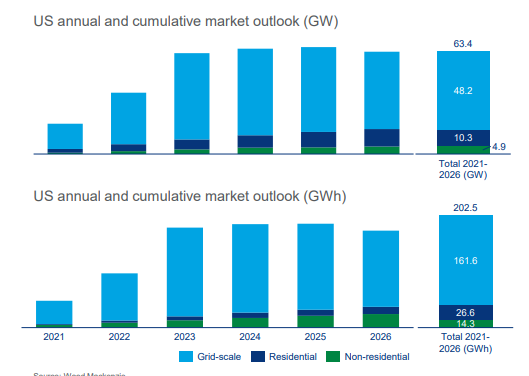Wood Mackenzie estimates that the US energy storage market broke records in Q4 2021, installing 1,613MW / 4727 MWh.
Despite not quite hitting the numbers anticipated, the US energy storage market set a new record in the fourth quarter of 2021, with new system installations totaling 4,727MWh, according to Wood Mackenzie and the American Clean Power Association’s (ACP) latest US Energy Storage Monitor report, released today.
And it could have been so much more. Due to supply chain challenges, over 2GW of grid-scale capacity originally slated to come online in Q4 2021 were delayed to 2022 and 2023.
Grid-scale
Annual deployments of grid-scale storage nearly tripled year-over-year to 3GW / 9.2GWh. An additional 770MW of late-stage capacity that was previously delayed is expected to come online, positioning Q1 2022 to deliver up to 1.7GW of capacity. These projects saw impressive deployments in certain Southern states, as well as from traditional market leaders this quarter such as California and Texas, where projects have an average duration of around three hours. Wood Mackenzie forecasts that supply chain pressures and interconnection-related delays will persist through 2024.
Projects are still being built at record-setting pace remain on track for exponential growth, despite supply chain and pricing issues. Module and BOS prices have caused some projects to be delayed while developers wait for capex to stabilize.
Residential
Residential storage had its strongest quarter to date with 123MW installed, (the previous quarterly record was 110MW in Q1 2021). Despite limited battery supply, the segment still managed to grow 85% between 2020 and 2021 in MWh terms, and this is in part due to solar-plus-storage sales in markets outside of California. The national annual total of installed residential energy storage amounted to 436MW.
By 2026, annual installations in the residential segment are expected to hit 2GW / 5.4GWh, with California, Puerto Rico, Texas, and Florida leading the way. The residential forecast assumes that the NEM 3.0 proposed decision in California will go into effect as written, although WoodMac analysts said that this is not a certain outcome. If it does not, the forecast would be reduced ~5% annually from 2023.
“2021 was yet another record for the U.S. energy storage market, with annual installations of multiple gigawatts for the first time,” said Jason Burwen, Vice President for Energy Storage at American Clean Power. “Even in the face of continued macro-economic headwinds, interconnection delays, and lack of proactive federal policy, increasing demand for resilient clean energy and volatility in the price of fuel-based generation will drive energy storage deployment forward.”
Non-residential
The non-residential storage segment delivered 131MWh in the fourth quarter resulting in 162MW / 350MWh of total annual deployments in 2021. Segment demand was driven by increased storage attachment rates within the community solar markets of New York and Massachusetts. The non-residential/community solar market is forecast to near 1GW annually in 2026.

Costs
Higher costs for raw materials and transportation have undercut system component price gains experienced over recent years. Specifically, the increased cost of raw materials resulted in battery module prices increase the most among all system components. Increased standardization has helped hold BOS steady, with few system components increasing, such as inverters and GSU.
The report found that despite policy uncertainty, the California storage market remains resilient, and by 2027, California is forecast to remain the largest residential storage market, with three-and-a-half times more storage installed annually in 2027 compared to 2021. Puerto Rico is also a strong market, as solar-plus-storage is embraced as a defense against the widescale power outages experienced in recent weather events.
“Puerto Rico’s position in the residential US solar-plus-storage market comes as no surprise, and demonstrates how outages can drive battery adoption, with thousands of new residential installs emerging each quarter and competition increasing between local installers,” said Chloe Holden, an analyst with Wood Mackenzie’s energy storage team.



